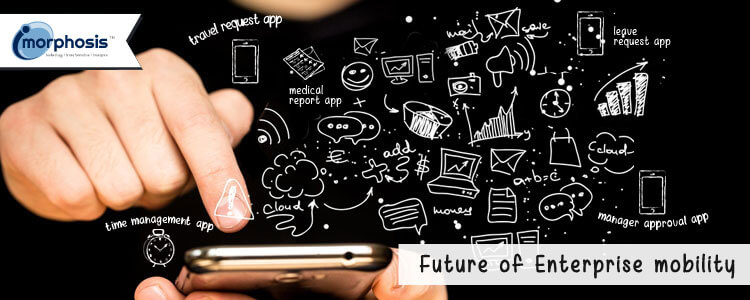Businesses need to adopt the right technology to stay ahead of the others. Be it a small, large or a medium business, Enterprise mobility is important for businesses to stay connected. Mobility solution improves the flexibility of work and explore infinite opportunities. Boost in productivity and growth of business are two main concerns of any enterprise. It is now increasingly important for business leaders to implement and adopt a sustainable mobility strategy for transforming the business operations to a mobile-centric environment.
Enterprise mobility makes relevant and important information handy, irrespective of the location, thus improving the productivity. Implementing mobility is particularly beneficial for businesses who have employees in remote locations or involved in field operations. By improving digital infrastructure, businesses can improve their efficiency, ensure greater flexibility and freedom to employees. The shift in the working patterns and surge in the use of mobile has urged enterprises to embrace mobility solutions.
Shift in Enterprise Mobility
Until a few years back, at the enterprise level mobility was restricted only to the use of smartphone by employees. However, the definition has changed and mobility is now not about accessing email on the smartphone rather empowering them with tools to boost efficiency, and streamline operations. Now it emphasizes on creating a conducive environment for employees where they can access information easily without falling prey to the menace of information overload that often results in improper or delayed decision making.
As per the predictions of Gartner, by 2017 almost half the workforce will abide by the BYOD or bring-your-own-device policy, which will increase the presence of mobile devices in the workplace. It is expected that by 2020, mobile employees will constitute approximately 72 percent of the workforce alone in the USA.
Recent Trends in Mobility
Experts predict that mobile devices and cloud applications will reign the work environment. The transition in mobility practice will gain momentum gradually. Factors that affect the mobility trend and employee practice are:
- Mobile User-Centricity – Enterprises need to emphasize on User-Centricity. Mobile is different from big-screen devices and the software or applications suitable for the big screen often fail to translate similar user experience on the smartphone. Initially complex activities were sliced to fragments that are easy to be processed and used by employees. But to ensure better productivity, push notifications for basic approvals, inventory and KPI is a good option and will rule.
- Personalization – Mobile is more personal device than a laptop or PC. Mobile and handheld devices bring technology at the fingertips of employees and help them to prioritize their actions.
- Consolidated user experience – To battle the app fatigue, it is important to create a consolidated experience for the users. Enterprises can improve the experience with the use of mobile apps rather than enterprise-level tools which might not necessarily have a mobile channel.
- Security policy– The security control over devices used in the workplace will be replaced by security policy and philosophies that starts at the granular level. The latter will be a fitting approach for the smartphone used in the workplace. Initially the apps developed by the enterprises were on an ad hoc, but gradually the apps emphasized on business workflow and security became a major concern. To streamline the configuration and management of app, developer need to take into consideration the configuration and app security framework of the mobile Operating Systems.
Enterprises need to think seriously these factors, if they want to reap the benefit of mobility in the workplace.
Source by tkxel
Empower and engage employees
For successful implementation of mobility, enterprises need to emphasize on two major areas- employee empowerment and employee engagement. The main aim of Enterprise mobility is to make complex things easy and convenient by adopting new technology and devices that the employees are familiar with.
Employee empowerment – Mobility eliminates the inefficiencies related to workflows, procedures and transaction times. To add value to any enterprise, it is important to empower the employees about mobility and improve the efficiency.
Employee engagement – Enterprises need to focus on employee engagement as it is the foundation of success. Engagement can be- communication with employees directly with relevant data and creating a connected environment. By embracing mobility practices, enterprises can improve employee motivation, participation and reach.
IoT and Big Data Analytics for Mobility
Internet of Things impacts how enterprises can leverage the connected devices and transform business. IoT empowers employees to be informed and online with connected devices. Businesses can rely on Big Data Analytics and IoT to make important decisions regarding operational strategies. So, how IoT fuels mobility? Smartphone is the connected device that can collect information and enterprises can utilize for process optimization.
Since many mobile devices are used in the workplace (either due to BYOD or those provided by the business), businesses can get detailed data about the employees. They can gain by utilizing this data. Thus, enterprises need to develop innovative and useful mobile apps to collect more relevant information that will help them in increasing their return on the investment. Thus, the future of enterprise mobility is associated with both IoT and Big Data Analytics as it improves operational efficiency.
The verdict
Businesses now need to take mobility seriously as it expands new frontiers and gives them an edge. Enterprise mobility is an innovative approach that aims at improving productivity and seamless information management. For improving the productivity and ROI, it is important to implement this approach as it integrates social interactions, documents, email, business updates and user experience.




